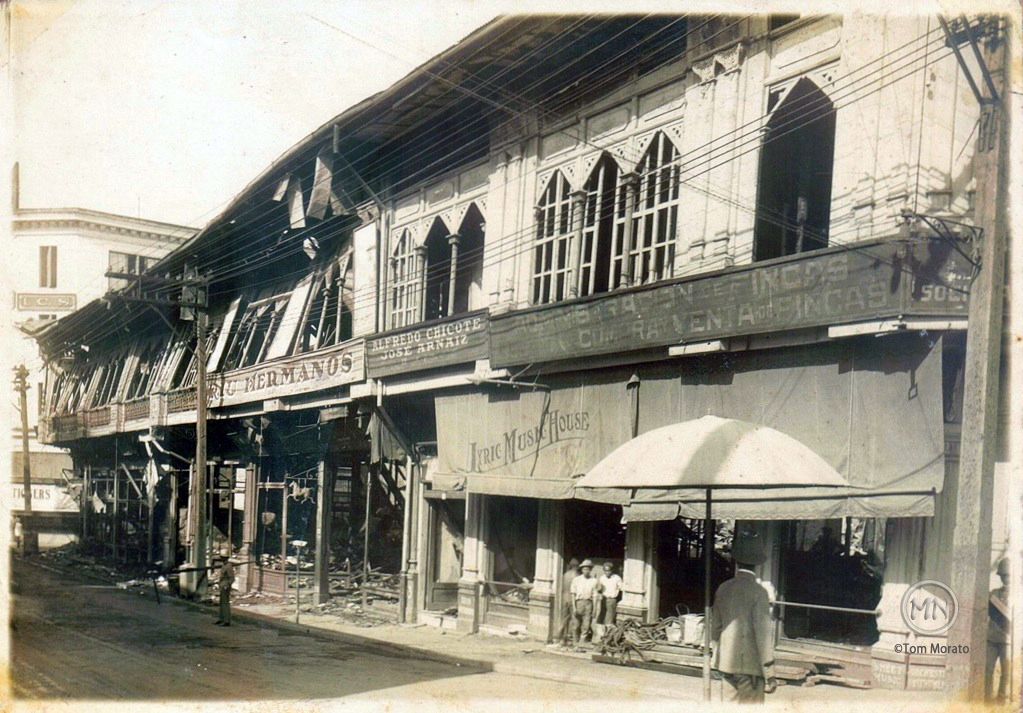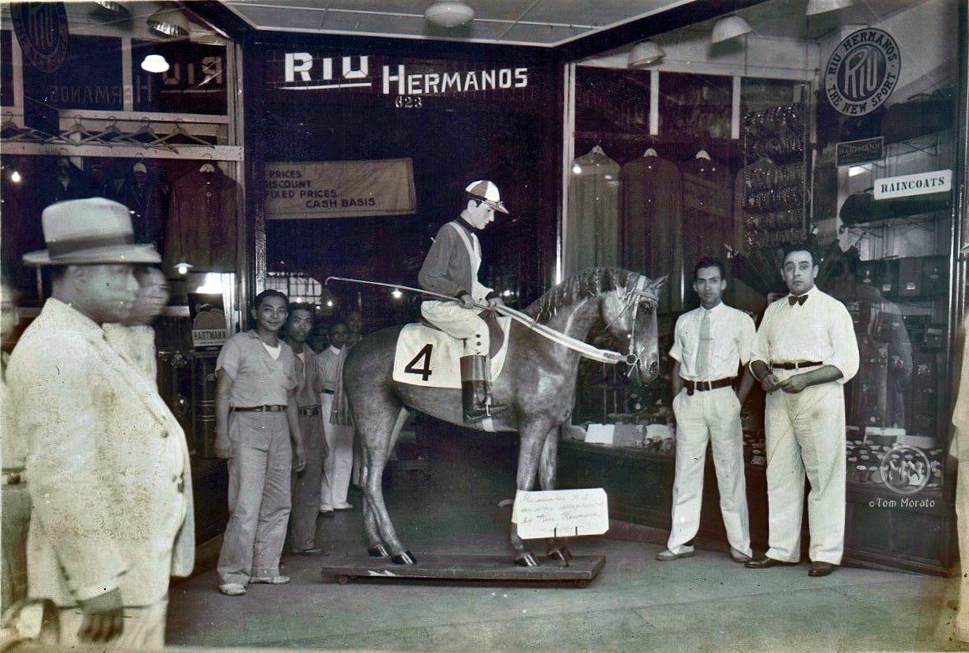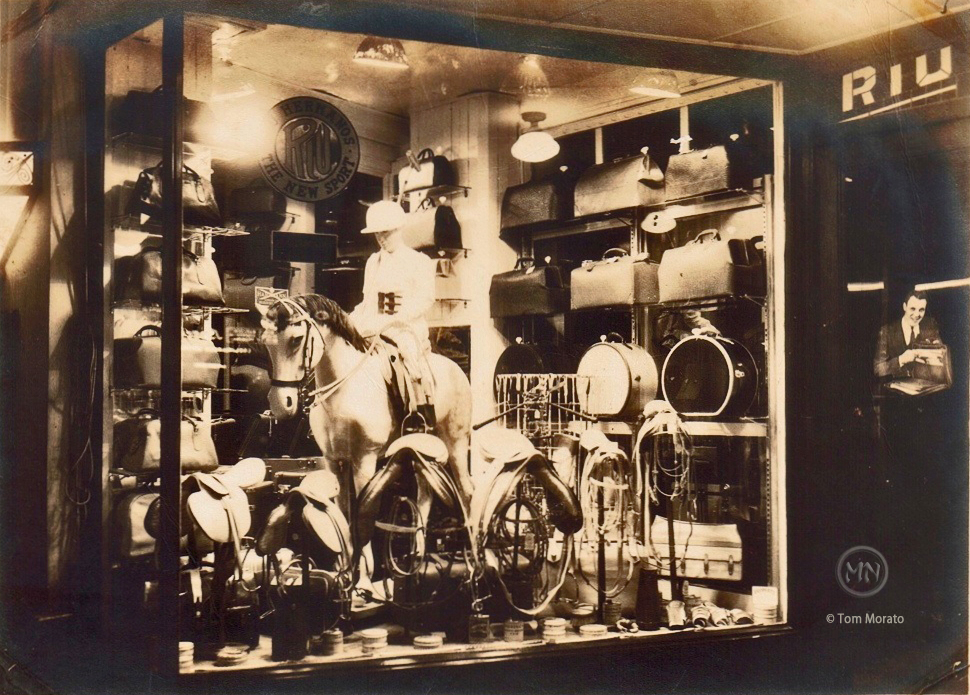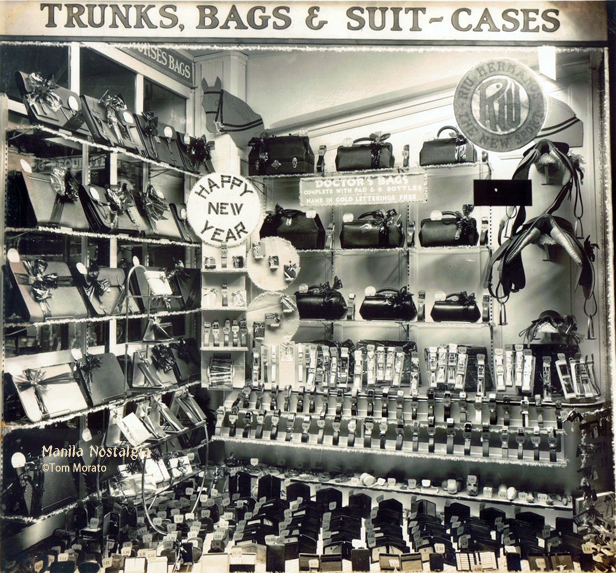Last year, one of my readers wrote to me regarding his great-grandfather Don Juan Riu of the Riu Hermanos store that operated in Manila since before the turn of the century. Tom Morato III was kind enough to provide much of the information about his family and their business as well as incredible photos of Manila’s past. I have included excerpts of his family’s story within the article.
Riu Hermanos
The Philippines was still a colony of Spain when Joaquin Riu arrived in Manila in 1893. Perhaps he may have followed a relative, Don Esteve “Esteban” Riu i Plana who was the first Riu to settle in Manila and establish a maritime consignment firm in the late 1870s. (source: Paquito de la Cruz). Escolta was not the purview of elite shopping then as it would be in the 1920s and 1930s. Small stores, protected from the sun and heat by large awnings, dominated the rather short and narrow street close to the Pasig.
 Its proximity to the river allowed goods and supplies to be offloaded directly onto the Muelle de la Industria that were carted off on carts pulled by carabaos to import/export and retail businesses just a short distance away in the Binondo and Santa Cruz districts.
Its proximity to the river allowed goods and supplies to be offloaded directly onto the Muelle de la Industria that were carted off on carts pulled by carabaos to import/export and retail businesses just a short distance away in the Binondo and Santa Cruz districts.
 Realizing the potential as a supplier of high quality equestrian equipment and saddlery, Joaquin opened one of the city’s first department stores at 153-155 Escolta corner of Pasaje Perez (Calle David) in a building owned by Don Rafael Perez-Samanillo.
Realizing the potential as a supplier of high quality equestrian equipment and saddlery, Joaquin opened one of the city’s first department stores at 153-155 Escolta corner of Pasaje Perez (Calle David) in a building owned by Don Rafael Perez-Samanillo.
Joaquin was soon joined by his younger brother, Juan, and under their management, the Riu Hermanos store flourished. It quickly became popular not only for its riding equipment but luggage and sporting goods as well. “My grandfather (Juan) was a good businessman. His early exposure to work started at the age of 13 in Birmingham, England. Learning the English language gave him an edge among the Spaniards here at the time.” – Tom Morato III
The variety and character of the innumerable articles pertaining to modern commerce is a subject on which many volumes could be written. Among these there is none that is more useful than leather. The versatility of its use is shown by the stock in Messrs. Riu Hermanos’ establishment at 153-155 Escolta. This firm are specialists in leather goods of all kinds. Messrs. Riu Hermanos’ assortment of saddles manifests the perfection to which these articles have been brought, and include all kinds for both ladies and gentlemen- soft and elastic seats that greatly enhance the pleasure of equestrian exercise. No less worthy is their display of harness, which comprises every item and device that makes for the comfort of the horse, the improvement of its appearance, and the reduction of its labour between the shafts. Whips, spurs, and stable requisites of every description are also largely in evidence, together with sporting goods. Repairs and orders for leather manipulation of all kinds are skillfully and promptly executed by experts, under the personal supervision of the proprietors, Messrs. J. and J. Riu. They have been established in Manila about fourteen years and their establishment adds considerably to the attractiveness and utility of the Escolta. (Seaports of the Far East, 1907)
“It was a leather goods store located along the main Escolta street. Their business became quite a success. They sold quality genuine leather wallets, bags, belts, boots, saddles,  and leggings for the Army. They also had air guns, buckles and other items. Their craftsmen were from Bulacan. According to my mother and aunt, Teodoro Toribio, the future owner of “Ang Tibay” also worked there and later put up his own shoe business.” – Tom Morato III
and leggings for the Army. They also had air guns, buckles and other items. Their craftsmen were from Bulacan. According to my mother and aunt, Teodoro Toribio, the future owner of “Ang Tibay” also worked there and later put up his own shoe business.” – Tom Morato III
Tragedy struck as the entire block of the former Samanillo building was razed during a fire on the night of September 21, 1922. It was apparently the work of an arsonist who rented a small room in the next building.
 The entire block was torn down and the new Perez-Samanillo building designed by Andres Luna, Juan Nakpil and Jose Cortes, was completed in 1928.
The entire block was torn down and the new Perez-Samanillo building designed by Andres Luna, Juan Nakpil and Jose Cortes, was completed in 1928.
 The store remained under the brothers’ management until 1937 when Joaquin and his French wife decided to leave the store to his brother and retire to Nice, France. Joaquin passed away in 1952.
The store remained under the brothers’ management until 1937 when Joaquin and his French wife decided to leave the store to his brother and retire to Nice, France. Joaquin passed away in 1952.
In the meantime, Juan met and married a local girl, Felisa de los Santos Cruz from Montalban, Rizal. Below is a photo of the couple taken in the mid-1930s.
“My mother became the store’s cashier when she was 19. According to her friends, she looked like Hedy Lamarr. There was an instance when a customer, after seeing her beside the cash register, frequented the store until Juan noticed that and told him to leave or he would call the police.” – Tom Morato III
Juan Riu stands outside the new store in the Perez-Samanillo Building. As the Polo fever hit the Philippines in the 1930s, the Riu Hermanos was the outfitter of many jockeys and horse owners from the Manila Jockey Club, the Manila Polo Club and Los Tamaraos Club as well as the horse teams from the U.S. Army.
Unlike the Americans, who were interned during the Japanese occupation leaving their stores abandoned and shuttered during the Japanese occupation, Riu Hermanos continued its operations although I imagine that the importation of goods would have been quite restrictive. Below are photos from the pre-occupation era.
“The store operated during the Japanese occupation. Juan risked his life by regularly giving money to the guerrillas, not knowing that his Spanish manager was a collaborator. We don’t know if that manager knew Juan was helping the Guerillas but after the Escolta area was liberated, the manager was shot by the local Guerillas.” -Tom Morato III
Below, a rare photo of the Escolta during the Japanese occupation. Riu Hermanos was located right across the street from Walk Over Shoes. (courtesy Lito Ligon)
 Unfortunately, tragedy struck the family during the Battle of Manila when an artillery shell killed Juan’s wife, Felisa and their son, Joaquin, aged 17. “My mother, Concepcion and her father, Don Juan Riu evacuated the area, carrying her 6 year old sister (Lourdes Riu-Andrews, mother of Bobby). Our family transferred to Quezon City after the war.” – Tom Morato III)
Unfortunately, tragedy struck the family during the Battle of Manila when an artillery shell killed Juan’s wife, Felisa and their son, Joaquin, aged 17. “My mother, Concepcion and her father, Don Juan Riu evacuated the area, carrying her 6 year old sister (Lourdes Riu-Andrews, mother of Bobby). Our family transferred to Quezon City after the war.” – Tom Morato III)
 The Battle of Manila destroyed much of the Escolta and the downtown area. Reconstruction followed into the early Fifties. Other stores came in to take over the old location of Riu Hermanos such as Berg’s and Assandas.
The Battle of Manila destroyed much of the Escolta and the downtown area. Reconstruction followed into the early Fifties. Other stores came in to take over the old location of Riu Hermanos such as Berg’s and Assandas.
Finding a suitable location, the store was relocated to the De Guzman building on R.Hidalgo in Quiapo. In 1952, it moved again to the Cu Unjieng Building on T.Pinpin street. Another branch was opened in 1952 at Padre Faura street in the Ermita district.
In 1966, the store and shop was transferred to Juan’s 1,500 square meter lot at his residence in Scout Gandia, Quezon City. In 1972 at the age of 94, Don Juan Riu, died in his sleep peacefully in his bedroom. His beloved store, Riu Hermanos died with him.

standing L-R: Juan Riu and Tommy Morato jr. seated: Concepcion Riu-Morato, Tom Morato III and Lourdes Riu (Quezon City)
My thanks and appreciation to Tom Morato III for this wonderful story of an important segment of Escolta’s history.
















